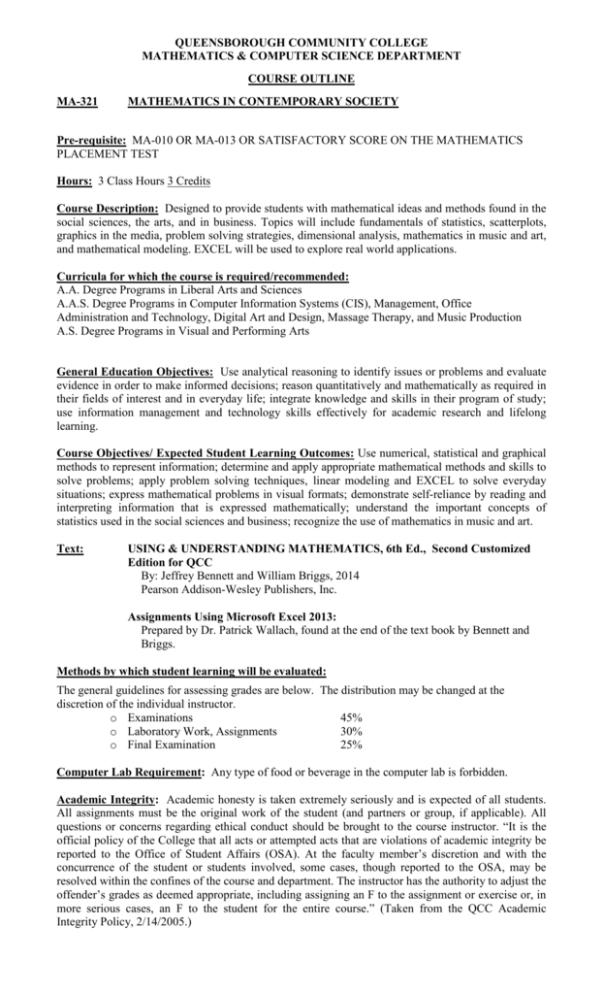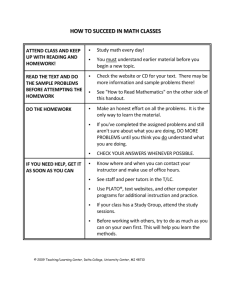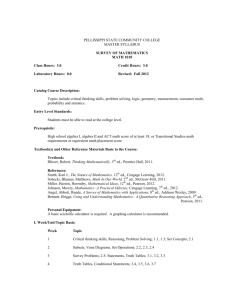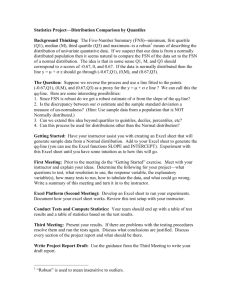
QUEENSBOROUGH COMMUNITY COLLEGE
MATHEMATICS & COMPUTER SCIENCE DEPARTMENT
COURSE OUTLINE
MA-321
MATHEMATICS IN CONTEMPORARY SOCIETY
Pre-requisite: MA-010 OR MA-013 OR SATISFACTORY SCORE ON THE MATHEMATICS
PLACEMENT TEST
Hours: 3 Class Hours 3 Credits
Course Description: Designed to provide students with mathematical ideas and methods found in the
social sciences, the arts, and in business. Topics will include fundamentals of statistics, scatterplots,
graphics in the media, problem solving strategies, dimensional analysis, mathematics in music and art,
and mathematical modeling. EXCEL will be used to explore real world applications.
Curricula for which the course is required/recommended:
A.A. Degree Programs in Liberal Arts and Sciences
A.A.S. Degree Programs in Computer Information Systems (CIS), Management, Office
Administration and Technology, Digital Art and Design, Massage Therapy, and Music Production
A.S. Degree Programs in Visual and Performing Arts
General Education Objectives: Use analytical reasoning to identify issues or problems and evaluate
evidence in order to make informed decisions; reason quantitatively and mathematically as required in
their fields of interest and in everyday life; integrate knowledge and skills in their program of study;
use information management and technology skills effectively for academic research and lifelong
learning.
Course Objectives/ Expected Student Learning Outcomes: Use numerical, statistical and graphical
methods to represent information; determine and apply appropriate mathematical methods and skills to
solve problems; apply problem solving techniques, linear modeling and EXCEL to solve everyday
situations; express mathematical problems in visual formats; demonstrate self-reliance by reading and
interpreting information that is expressed mathematically; understand the important concepts of
statistics used in the social sciences and business; recognize the use of mathematics in music and art.
Text:
USING & UNDERSTANDING MATHEMATICS, 6th Ed., Second Customized
Edition for QCC
By: Jeffrey Bennett and William Briggs, 2014
Pearson Addison-Wesley Publishers, Inc.
Assignments Using Microsoft Excel 2013:
Prepared by Dr. Patrick Wallach, found at the end of the text book by Bennett and
Briggs.
Methods by which student learning will be evaluated:
The general guidelines for assessing grades are below. The distribution may be changed at the
discretion of the individual instructor.
o Examinations
45%
o Laboratory Work, Assignments
30%
o Final Examination
25%
Computer Lab Requirement: Any type of food or beverage in the computer lab is forbidden.
Academic Integrity: Academic honesty is taken extremely seriously and is expected of all students.
All assignments must be the original work of the student (and partners or group, if applicable). All
questions or concerns regarding ethical conduct should be brought to the course instructor. “It is the
official policy of the College that all acts or attempted acts that are violations of academic integrity be
reported to the Office of Student Affairs (OSA). At the faculty member’s discretion and with the
concurrence of the student or students involved, some cases, though reported to the OSA, may be
resolved within the confines of the course and department. The instructor has the authority to adjust the
offender’s grades as deemed appropriate, including assigning an F to the assignment or exercise or, in
more serious cases, an F to the student for the entire course.” (Taken from the QCC Academic
Integrity Policy, 2/14/2005.)
NOTE: Any student who feels that he/she may need an accommodation based upon the impact of a
disability should contact the instructor privately to discuss his/her specific needs. Please contact the
office of Services for Students with Disabilities in Science Building, room 132 (718 631 6257) to
coordinate reasonable accommodations for students with documented disabilities.
SUBJECT MATTER
Fundamentals of Statistics: Surveys, sampling
methods, types of statistical studies, questioning
results of a study
SECTIONS
5A-5B
HOURS
3
Statistical tables, graphs, frequency tables,
histograms, line charts, pie charts, time-series
diagrams
5C
4
Graphics in the media, graphic distortion
5D
2
Correlation, causality
5E
2
Characteristics of Data: Mean, Median, Mode,
Outliers, Shapes of Distributions
6A
3
Measures of Variation
6B
2
6C-6D
4
2A
2
2B-2C
3
Mathematics and the Arts: Scales, octaves,
exponential growth, perspective, symmetry, tiling,
proportion, golden ratio
11A-11C
5
Functions and Modeling: Representing functions,
domain, range, linear models
9A-9B
3
Normal distribution, statistical inference
Approaches to Problem Solving: Units,
conversions
Standardized units, problem-solving strategies
REVIEW AND EXAMS INCLUDING FINAL
EXAM
4
Total 37
The approximate hours per chapter are guidelines and are at the discretion of the instructor. The
instructor is responsible for making assignments and scheduling examinations.
EXCEL LABORATORY SCHEDULE
At the discretion of the instructor, the laboratory assignments may be given every other week and be
based on the Assignments Using Microsoft Excel 2013 prepared by Dr. Patrick Wallach.
SUBJECT MATTER
Introduction to Excel
Frequency Tables & Graphs, Other Graphs
Correlation
Using Your Own Data Set, Statistical Project
Z-scores and Percentiles
Problem Solving
Exponents in Excel
SUGGESTED
LAB ASSIGNMENT
0, 1
3 or 4
5
6 or 7
8
9
10
Projects and Excel Exam
Total
ET/PW:cs
FALL 2014
HOURS
1
1
1
1
1
1
1
1
8






